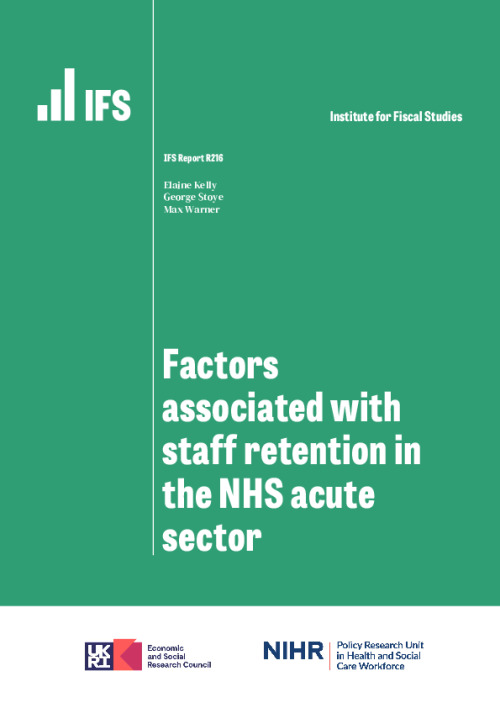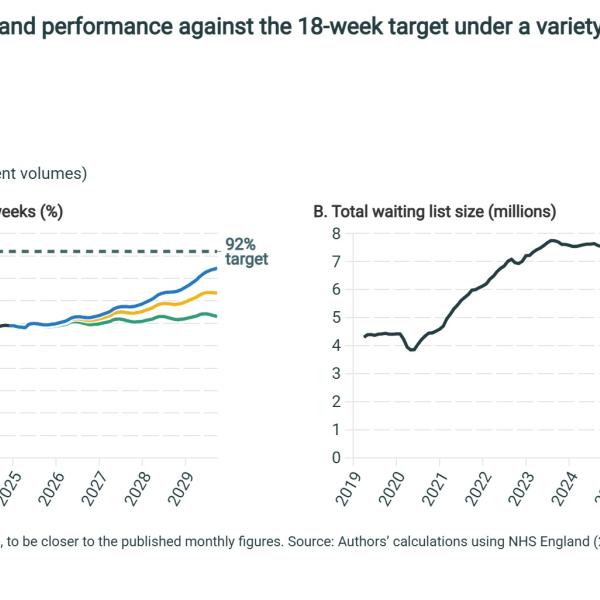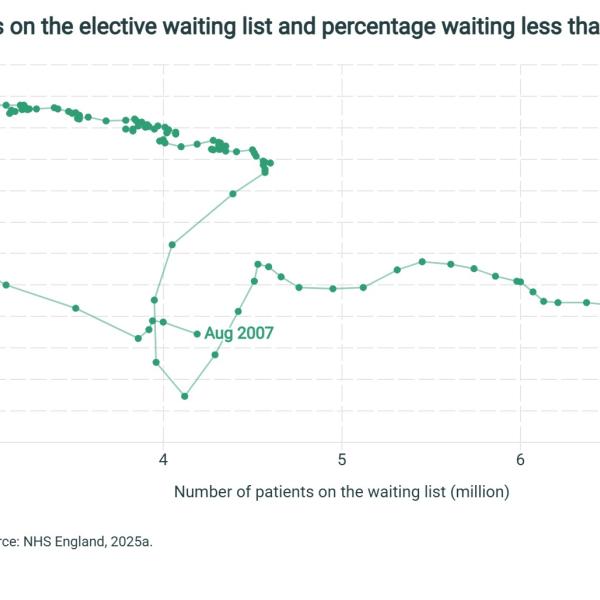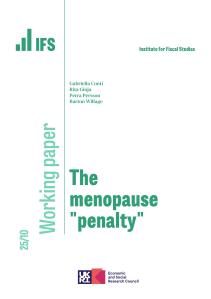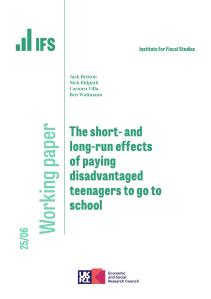Against a backdrop of increasing demands for health care, the National Health Service (NHS) has long sought ways to increase the number of staff available to provide care to patients. More doctors, nurses, midwives and health-care assistants (HCAs) mean that the NHS can deliver more, and higher-quality, care. Increasing staff numbers is a clear policy priority, as reflected in the 2019 Conservative Party’s manifesto commitment to increase the number of nurses by 50,000 by 2024, and demand for staff has only intensified in the wake of the pandemic and the subsequent backlog in elective care.
In addition to hiring new staff, the retention of existing staff is crucial in ensuring adequate numbers of NHS staff. These staff members have important skills and experience working in the NHS, and the supply of alternative medical staff is often restricted in the short term, with long training pathways and only a limited amount of staff who can be recruited from abroad. Retaining existing staff members and their skills is therefore important to ensure a well-functioning NHS. However, the evidence on which factors matter for retention of existing staff remains scarce.
In this report we add to this evidence base by examining how a range of individual staff characteristics, regional economic conditions and trust characteristics are associated with whether individual staff members decide to leave the NHS acute sector. We use the Electronic Staff Record (ESR), the monthly payroll of the NHS, to analyse how much of the variation in retention rates between NHS acute trusts can be explained by these characteristics, and to examine which factors were associated with the leaving decisions of medical consultants, nurses and midwives, and HCAs between 2012 and 2021.
While these findings cannot distinguish the causal impact of different factors on retention, they provide new evidence on the characteristics of staff who are most likely to leave the NHS acute sector, and can guide further policy interventions to improve the retention of these groups.
Key findings
- Average monthly leaving rates differ substantially between NHS staff groups, but have remained stable over time. On average, 0.4% of consultants left the NHS acute sector each month between April 2012 and May 2021. The average leaving rate was 0.8% for nurses and midwives over the same period, and 1.2% for HCAs.
- Retention rates vary considerably between different trusts. For example, the average monthly leaving rate of HCAs was nine times higher at the trust with the worst retention rates (4.50%) than at the trust with the highest retention rate (0.49%). There were large regional differences in leaving rates for all staff groups, but in all regions there remained significant variation. The North East had the lowest leaving rates for consultants, nurses and midwives, and HCAs. London, the South and East of England had the highest leaving rates for nurses and midwives, and HCAs.
- The majority of variation in monthly leaving rates between trusts remains unexplained by our model of retention. We studied three sets of observable, time-varying factors that could plausibly be related to retention – individual staff characteristics, local economic conditions and trust characteristics – in addition to controlling for nationwide time trends and persistent differences in leaving rates across trusts that are associated with fixed (and often unobserved) trust attributes. Together, this explains between 11% and 21% of the variance in trust leaving rates for each staff group. This highlights that much of what drives retention is often unobservable to researchers or policymakers, and makes targeting interventions at these unobserved factors difficult.
- Age is strongly associated with leaving decisions, with different patterns for men and women. Female staff are most likely to leave the acute sector in their 30s, all else being equal, while male staff leaving rates start rising substantially from 55. Tenure at a particular trust is also strongly associated with leaving decisions, even after controlling for age. Staff members with the shortest tenures were most likely to leave the acute sector entirely, with those having a tenure of less than two years 43%–109% more likely to leave in a given month than those with a tenure of 5–10 years.
- Consultants who are British nationals were less likely to leave in any given month than their non-British counterparts, while HCAs who are British nationals were more likely to leave. EU nurses were 43% more likely to leave than British nurses, while non-EU nurses were 28% less likely to leave. This pattern pre-dates the 2016 EU Referendum, but the differences in leaving rates between groups have grown since 2016.
- Staff members who had a recent sickness absence were much more likely to subsequently leave the acute sector. This was true for absences related to physical health, and even stronger for absences related to mental health. A nurse or midwife who missed three days of work for mental health reasons was 27% more likely to leave three months later than a peer with no absences. For a consultant, this difference was 58%.
- The leaving decisions of nurses and midwives, and HCAs were negatively correlated with regional unemployment rates, but not short-term changes in house prices. A percentage point increase in the regional unemployment rate was associated with a 2.1% reduction in the probability that a nurse or midwife left, and a 2.6% fall in the probability that an HCA left. There was no association with consultant leaving rates. Trust operational performance was largely unrelated to leaving rates for any staff group.
- Different NHS Staff Survey themes were associated with the probability of leaving for different staff groups. For nurses, higher reported staff engagement was associated with a lower probability of leaving. For consultants, higher satisfaction with immediate managers was associated with a lower probability of leaving, while for HCAs the probability of leaving was associated with the quality of team working.
- There were large, persistent differences in leaving rates associated with the characteristics of trusts that do not vary over time. These persistent differences are only weakly correlated between different staff groups, suggesting that different persistent trust characteristics matter for the retention of different staff groups.
- The share of these persistent differences that can be explained by region, trust type and trust size is much higher for nurses and midwives than the other staff groups. For nurses and midwives, almost half of these persistent differences in leaving rates was explained by trust type, size and region, suggesting that these are important factors in explaining the retention performance of different trusts. In contrast, only 13% and 7% of this variation was explained by these three factors for consultants and HCAs, respectively. This suggests that the vast majority of persistent differences in the retention of different trusts in these staff groups are explained by trust and job characteristics that are not correlated with the region, type or size of each trust.

